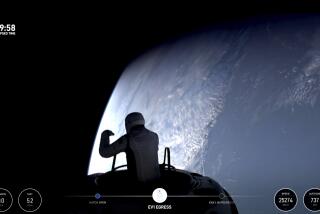NASA’s Balancing Act Passes Test
- Share via
HOUSTON — Two spacewalkers bounced around on the end of a “skinny little pole” 210 miles above Earth on Saturday in a daring test for future shuttle repairs.
Astronauts Piers J. Sellers and Michael E. Fossum spent 7 1/2 hours outside shuttle Discovery on the fourth day of the ship’s visit to the International Space Station. Anchored to a boom held by Discovery’s robotic arm, the pair checked whether the 100-foot-long appendage was stable enough to support delicate maintenance work on the shuttle’s heat shield.
Sellers, who performed three spacewalks during a 2002 shuttle visit to the station, was the first to stand at the end of the boom. As he was hoisted to a spot above the shuttle’s cargo bay, he noted the smoothness of the ride.
“Very steady,” Sellers said. “It’s like being on a slow elevator.”
Moments later, Sellers performed three sets of movements, leaning back and forth to simulate motions that would be used during repair work. The movements resembled a calisthenics session.
“It gets easier as you go along, doing all these tasks, you know, at the end of a skinny little pole,” Sellers said. “A little practice makes perfect -- or adequate.”
When his turn came, Fossum, a rookie astronaut making his first spacewalk, mimicked the motions of someone making repairs to the orbiter’s heat-resistant tiles and reported the operation was “no problem.” Later, with both spacewalkers at the end, the boom showed more movement, but the swaying appeared to quickly stop.
Engineers had expected the vibrations to last up to a minute. Most dissipated in 15 to 20 seconds. The preliminary results led shuttle managers to conclude the test was a success.
“That’s given us very good confidence,” said Tony Ceccacci, the mission’s lead flight director. “Hopefully, we’ll never have to use it, but we know we have the capability.”
Saturday’s success bode well for a possible repair: plucking a card-like piece of ceramic-coated fabric from between heat-resistant tiles on Discovery’s belly.
Engineers have been analyzing whether a gap filler protruding more than an inch from the rear of Discovery’s heat shield could raise temperatures to dangerously high levels during the ship’s descent through Earth’s atmosphere.
A spacewalker performed two similar repairs during Discovery’s flight last year. NASA officials are expected to announce today that a fix will not be needed this time.
NASA also finished its evaluation of questionable spots on two thermal panels that line the leading edge of Discovery’s right wing. Engineers concluded Saturday that the spots would not pose a hazard for the shuttle’s return flight.
More to Read
Sign up for Essential California
The most important California stories and recommendations in your inbox every morning.
You may occasionally receive promotional content from the Los Angeles Times.










